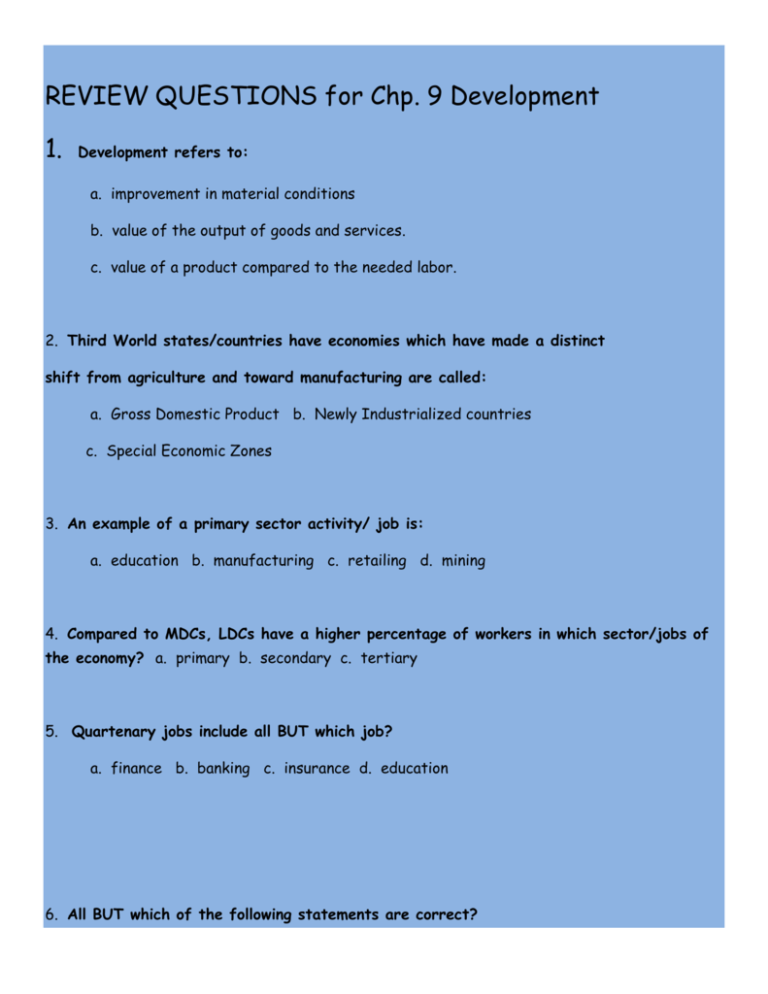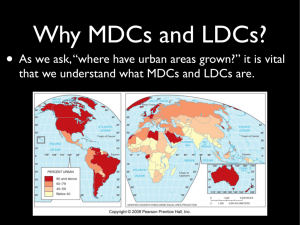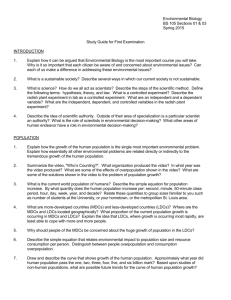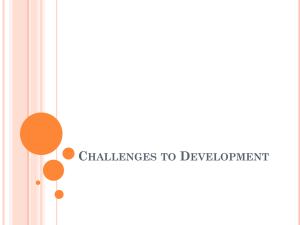REVIEW QUESTIONS for Chp. 9 Development 1. Development
advertisement

REVIEW QUESTIONS for Chp. 9 Development 1. Development refers to: a. improvement in material conditions b. value of the output of goods and services. c. value of a product compared to the needed labor. 2. Third World states/countries have economies which have made a distinct shift from agriculture and toward manufacturing are called: a. Gross Domestic Product b. Newly Industrialized countries c. Special Economic Zones 3. An example of a primary sector activity/ job is: a. education b. manufacturing c. retailing d. mining 4. Compared to MDCs, LDCs have a higher percentage of workers in which sector/jobs of the economy? a. primary b. secondary c. tertiary 5. Quartenary jobs include all BUT which job? a. finance b. banking c. insurance d. education 6. All BUT which of the following statements are correct? a. The higher the GDP of a country, the more equal its income distribution. b. The primary sector jobs account for a larger share of GDP for LDCs than MDCs. c. Workers in MDCs are more productive than LDCs. 7. This is money from international investors/transnational corporations who are looking to earn a profit by using the labor in LDCs is: a. Fair Trade b. Foreign Direct Investment c. Grameen Bank 8. People are more productive in MDCs because they a. work harder b. have access to more technology c. are better educated 9. Even though a higher percentage of GDP is spent on education in LDCs a. more women than men have access to education in LDCs. b. LDCs spend less per pupil than MDCs c. LDCs have smaller average class sizes than MDCs 10. Which of the following is not an indicator of a country's level of development? a. infant mortality rate. b. literacy rate c. age structure d. crude death rate e. natural increase rate 11. The major asset of the Russian Region is__________. 12. Japan's principal asset for promoting development is _______. 13. South Asia's agriculture depends yearly on what to arrive? _____ 14. The LDC region with the highest percentage of people living in urban areas is: a. Latin America b. South Asia c. East Asia d. SW Asia 15. The GDI a. compares the level of development of women in a country to the average development level of women in the world. b. compares the levels of indicators for females to those of males within a country. c. is composed of the same measures as the HDI but is applied only to women instead of the entire population. 16. The GEM a. combines economic and political indicators of empowerment. b. compares the levels of indicators for females to those of males within a country. c. is composed of the same measures as the HDI. 17. The biggest problem in promoting development through the International Trade/Rostow's Model is a. increased demand for many goods. b. increased price of petroleum/oil. c. unequal distribution of resources. 18. The principal benefit of the Self-Sufficiency Model of Development approach is to promote a. balanced growth of all economic sectors/jobs. b. global competiveness for local industries. c. the maintenance of a large bureaucracy. 19. Which of the following is NOT an indicator of gender inequality? a. women on average have 2/3s of the income of men in MDCs b. women have much lower incomes than men in LDCs. c. Female life expectancy is less than males in every country of the world. 20. The Four Asian Tigers (original) include all but a. Japan b. South Korea c. China d. Taiwan e. British Hong Kong 21. This is a market economy based on supply and demand with little or no government control: a. Free market b. Subsistence economy c. World Trade Organization d. Exclusive Economic Zone 22. LDCs can receive loans from all BUT a. IMF b. World Bank c. Fair Trade d. Grameen Bank 23. This is an agricultural economy in which there are low levels of production and farmers barely can provide for the basic necessities for themselves and their family. a. Self-Sufficiency b. Subsistence c. Sustainable 24. NAFTA is a trade agreement with all of the countries EXCEPT: a. USA b. Mexico c. Great Britain d. Canada 25. Which is not a Stage of Rostow's? a. Traditional Society b. Transitional Stage c. High Mass Consumption d. Drive to the First World 26. Quinary sector jobs include all but which? a. education b. banking c. health d. entertainment e. tourism 27. World Trade Organization's prime responsibility is to: a. provide loans for struggling LDCs b. provide living resources like fisheries and forestry c. promote international trade 28. Which organization creates Development Indexes for the world? _______ 29. Dependency Theory states that LDCs tend to have a higher dependency ratio, the ratio of the # of people under ___ and over __ in a labor face. 30. Which country has not been improved by Rostow's International Model of Development? a. India b. Cuba c. Saudi Arabia d. South Korea 31. According to the Rostow's International Trade approach to development, a country should identify all BUT which of the following assets? a. abundant agricultural products b. high quality manufactured goods c. imports to be limited d. international consumer preferences 32. The value of a particular product compared to the amount of labor needed to make it is: a. value added b. productivity c. GDP 33. Compares the levels of development of women with that of both sexes: a. GDI b. GEM c. HDI d. IMF e. WTO 34. Compares the ability of women and men to participate in economic and political decision making: a. GDI b. GEM c. HDI d. IMF e. WTO 35. Economic policies imposed on less developed countries by international agencies to create conditions encouraging international trade, such as raising taxes, reducing government spending, controlling inflation, and repaying loans. a. Self-Sufficiency b. Structural Adjustment Program c. Foreign Direct Investment 36. Rostow's 5 Stages Stage 1: Traditional Society - agricultural - USA what year? Stage 2: Pre-conditions for Take Off - industrial Revolution - elite group initiates innovative economic activities. - USA what year? Stage 3: The Take-off - rapid growth - textiles and food Stage 4: Drive to Maturity - modern technology - USA what year? Stage 5: Mass Consumptions: shift from heavy industry to consumer goods such as cars and refrigerators and the latest gadgets. USA what year?






